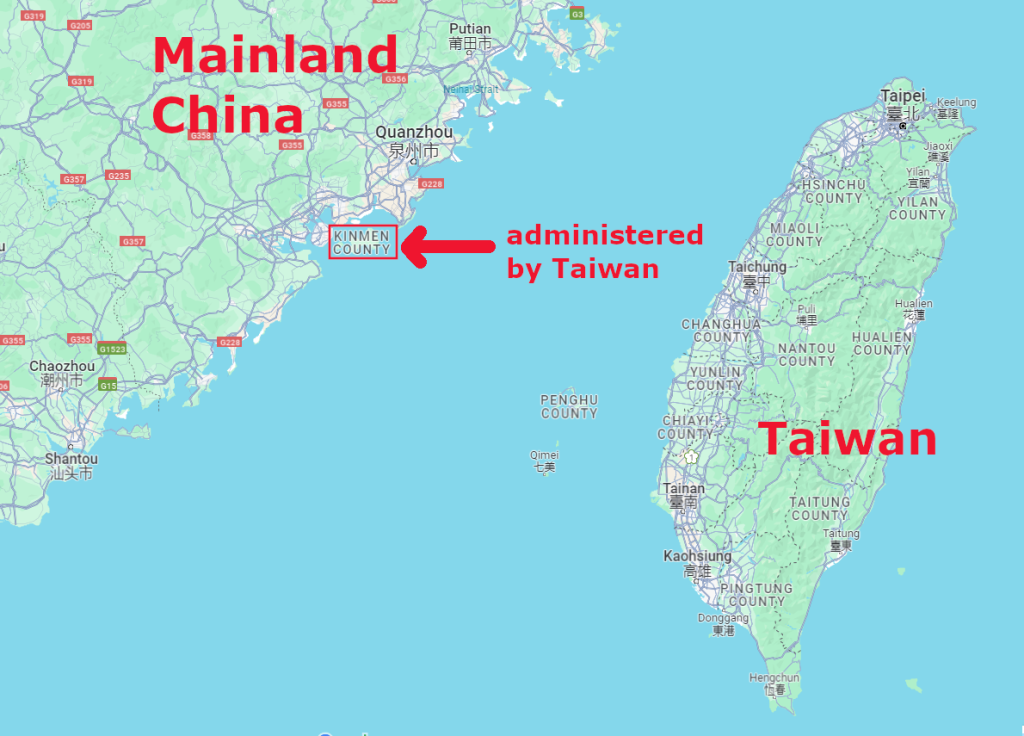US Troops on Taiwan’s Kinmen: A Powder Keg

All Global Research articles can be read in 51 languages by activating the Translate Website button below the author’s name (only available in desktop version).
To receive Global Research’s Daily Newsletter (selected articles), click here.
Click the share button above to email/forward this article to your friends and colleagues. Follow us on Instagram and Twitter and subscribe to our Telegram Channel. Feel free to repost and share widely Global Research articles.
Global Research Fundraising: Stop the Pentagon’s Ides of March
***
Kinmen is a handful of small Islands with a total of under 130,000 people under Taiwan’s control. Kinmen is situated more than 150 km away from Taiwan, only 2 km away from mainland China. It only takes a quick view of the map (below) to understand that Kinmen is indefensible for Taiwan. China can with ease can take Kinmen with little or no bloodshed at any time.
Kinmen already earns massively from tourist visitors from China. Kinmen has asked China to build a bridge to increase the number of tourists, and to build a pipe to supply Kinmen with freshwater from the mainland. There have also been talks about making Kinmen a free-trade zone for China. Relations between the people on Kinmen and on mainland China are very fruitful. No reason for Beijing to let Taipei administer Kinmen in the future.
Some months ago, the US stationed troops on Kinmen, ostensibly “non-combat” troops for training the Taiwanese forces.
Taiwan has now officially acknowledged the presence of US troops on Kinmen. In addition to US troops on Kinmen, tensions China-Taiwan are heating up in the waters around Kinmen. It started with an “incident” where mainland fishermen died. Since then, China is stepping up maritime and aerial pressure on Kinmen.
Very little word from mainland China about what really happened during the fatal accident where two mainland fishermen died at the beginning of March 2024. The background could be anything – including a planned build-up to pressure Taipei and Washington, or even to outright overtake Kinmen.
China is officially (still) “only” using its Coast Guard to patrol Kinmen. But note, that China’s “Coast Guard” is stronger than most navies in the World.
The leading Chinese “Coast Guard Ship” around Kinmen is actually a big Frigate transferred from the Chinese Navy to the Coast guard. It would be extremely easy for China to invade and seize control of Kinmen. China wouldn’t even need to use its navy or military – China could simply declare “unrest” on Kinmen and use the Coast Guard and the Chinese police to “restore order” under Beijing’s control. In which case, US troops on Kinmen would be of course be captured as prisoners, not of war, but as suspects of helping an unlawful uprising against Beijing. There is absolutely nothing neither Taipei nor Washington could do to hold on to Kinmen under such a scenario.
US firing weapons in anger against China for taking Kinmen? Forget it. US blockading all China’s sea routes or the US stopping all Chinese exports to the US for the sake of Kinmen? No, come on. Besides, Taiwan depends fully on mainland China for its food and energy supplies. A few ridiculous US sanctions, that would be all.
The Chinese leadership in Beijing is holding back a lot. But for sure, Beijing already got extremely angered when it surfaced 7 October 2021 that US troops have been present on Taiwan for over a year. Beijing got even more upset again, when Biden then just about doubled the US number of troops on Taiwan. So, when the US in only months ago moved some of those its troops from Taiwan island to the Kinmen islands, only a couple of kilometers from China’s coast, there is no doubt that this was seen as an extreme provocation by Beijing. US troops on Kinmen serve no military purpose, they only represent a bunch of potential prisoners to be captured by China in any situation. US leaders are not the sharpest in the World. The provocation of the US placing its troops on Chinese soil (Kinmen like Taiwan is part of China) of course comes on top of all the other things the US has done, especially under Biden, to anger Beijing by moving Taiwan towards de-facto independence.
Anger in Beijing aside – take a look at the broader picture. What other options does China have to physically move towards reunification with Taiwan? An outright invasion of Taiwan is possible and would succeed, even if the US entered a war on Taiwan’ side. But a war is also costly in terms of lives and treasure. Better to do some upscaling steps first. More plausible is a Chinese blockade of Taiwan, though that is also a big step.
So how about a quickie? An invasion of Kinmen will be fast and could be very beneficial for Beijing. Taking Kinmen, Beijing will show that it is serious about reunification – that signal will be an earthquake on Taiwan and in the USA. And China taking some US troops prisoner on Kinmen and displaying them to the World would humiliate the USA.
Angered by the USA, seizing Kinmen must be very tempting indeed for Beijing.
*
Note to readers: Please click the share button above. Follow us on Instagram and Twitter and subscribe to our Telegram Channel. Feel free to repost and share widely Global Research articles.
Karsten Riise is a Master of Science (Econ) from Copenhagen Business School and has a university degree in Spanish Culture and Languages from Copenhagen University. He is the former Senior Vice President and Chief Financial Officer (CFO) of Mercedes-Benz in Denmark and Sweden.
He is a regular contributor to Global Research.
Featured image is from TRT World


